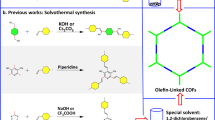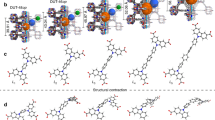Abstract
A critical bottleneck for the use of natural gas as a transportation fuel has been the development of materials capable of storing it in a sufficiently compact form at ambient temperature. Here we report the synthesis of a porous monolithic metal–organic framework (MOF), which after successful packing and densification reaches 259 cm3 (STP) cm−3 capacity. This is the highest value reported to date for conformed shape porous solids, and represents a greater than 50% improvement over any previously reported experimental value. Nanoindentation tests on the monolithic MOF showed robust mechanical properties, with hardness at least 130% greater than that previously measured in its conventional MOF counterparts. Our findings represent a substantial step in the application of mechanically robust conformed and densified MOFs for high volumetric energy storage and other industrial applications.
This is a preview of subscription content, access via your institution
Access options
Access Nature and 54 other Nature Portfolio journals
Get Nature+, our best-value online-access subscription
$29.99 / 30 days
cancel any time
Subscribe to this journal
Receive 12 print issues and online access
$259.00 per year
only $21.58 per issue
Buy this article
- Purchase on Springer Link
- Instant access to full article PDF
Prices may be subject to local taxes which are calculated during checkout




Similar content being viewed by others
References
Makal, T. A., Li, J.-R., Lu, W. & Zhou, H.-C. Methane storage in advanced porous materials. Chem. Soc. Rev. 41, 7761–7779 (2012).
Mason, J. A. et al. Methane storage in flexible metal–organic frameworks with intrinsic thermal management. Nature 527, 357–361 (2015).
Schoedel, A., Ji, Z. & Yaghi, O. M. The role of metal–organic frameworks in a carbon-neutral energy cycle. Nat. Energy 1, 16034 (2016).
He, Y., Zhou, W., Qian, G. & Chen, B. Methane storage in metal–organic frameworks. Chem. Soc. Rev. 43, 5657–5678 (2014).
Peng, Y. et al. Methane storage in metal–organic frameworks: current records, surprise findings, and challenges. J. Am. Chem. Soc. 135, 11887–11894 (2013).
Alezi, D. et al. MOF crystal chemistry paving the way to gas storage needs: aluminum-based soc-MOF for CH4, O2, and CO2 storage. J. Am. Chem. Soc. 137, 13308–13318 (2015).
Moghadam, P. Z. et al. Development of a Cambridge Structural Database subset: a collection of metal–organic frameworks for past, present, and future. Chem. Mater. 29, 2618–2625 (2017).
Wilmer, C. E. et al. Large-scale screening of hypothetical metal–organic frameworks. Nat. Chem. 4, 83–89 (2012).
Chung, Y. G. et al. Computation-ready, experimental metal–organic frameworks: a tool to enable high-throughput screening of nanoporous crystals. Chem. Mater. 26, 6185–6192 (2014).
Mason, J. A., Veenstra, M. & Long, J. R. Evaluating metal–organic frameworks for natural gas storage. Chem. Sci. 5, 32–51 (2014).
Casco, M. E. et al. High-pressure methane storage in porous materials: are carbon materials in the pole position? Chem. Mater. 27, 959–964 (2015).
Tian, T., Velazquez-Garcia, J., Bennett, T. D. & Fairen-Jimenez, D. Mechanically and chemically robust ZIF-8 monoliths with high volumetric adsorption capacity. J. Mater. Chem. A 3, 2999–3005 (2015).
Bueken, B. et al. Gel-based morphological design of zirconium metal-organic frameworks. Chem. Sci. 8, 3939–3948 (2017).
Tan, G., John, V. T. & McPherson, G. L. Nucleation and growth characteristics of a binary low-mass organogel. Langmuir 22, 7416–7420 (2006).
Fairén-Jiménez, D., Carrasco-Marín, F. & Moreno-Castilla, C. Inter-and intra-primary-particle structure of monolithic carbon aerogels obtained with varying solvents. Langmuir 24, 2820–2825 (2008).
Fairen-Jimenez, D. et al. Surface area and microporosity of carbon aerogels from gas adsorption and small-and wide-angle X-ray scattering measurements. J. Phys. Chem. B 110, 8681–8688 (2006).
Pekala, R. Organic aerogels from the polycondensation of resorcinol with formaldehyde. J. Mater. Sci. 24, 3221–3227 (1989).
Dorcheh, A. S. & Abbasi, M. Silica aerogel; synthesis, properties and characterization. J. Mater. Process. Technol. 199, 10–26 (2008).
Horcajada, P. et al. Colloidal route for preparing optical thin films of nanoporous metal–organic frameworks. Adv. Mater. 21, 1931–1935 (2009).
Li, L. et al. A synthetic route to ultralight hierarchically micro/mesoporous Al (III)-carboxylate metal-organic aerogels. Nat. Commun. 4, 1774 (2013).
Kim, K.-J. et al. High-rate synthesis of Cu–BTC metal–organic frameworks. Chem. Commun. 49, 11518–11520 (2013).
Getzschmann, J. et al. Methane storage mechanism in the metal-organic framework Cu3(btc)2: An in situ neutron diffraction study. Microporous Mesoporous Mater. 136, 50–58 (2010).
Nune, S. K. et al. Synthesis and properties of nano zeolitic imidazolate frameworks. Chem. Commun. 46, 4878–4880 (2010).
Cravillon, J. et al. Rapid room-temperature synthesis and characterization of nanocrystals of a prototypical zeolitic imidazolate framework. Chem. Mater. 21, 1410–1412 (2009).
Pan, Y., Liu, Y., Zeng, G., Zhao, L. & Lai, Z. Rapid synthesis of zeolitic imidazolate framework-8 (ZIF-8) nanocrystals in an aqueous system. Chem. Commun. 47, 2071–2073 (2011).
Sánchez-Sánchez, M. et al. Synthesis of metal–organic frameworks in water at room temperature: salts as linker sources. Green Chem. 17, 1500–1509 (2015).
Lemmon, E. W., McLinden, M. O. & Friend, D. G. Thermophysical Properties of Fluid Systems. in NIST Chemistry WebBook, NIST Standard Reference Database Number 69 (eds Linstrom, P. J. & Mallard, W. G.) (National Institute of Standards and Technology, 2005).
Fairen-Jimenez, D. et al. Understanding excess uptake maxima for hydrogen adsorption isotherms in frameworks with rht topology. Chem. Commun. 48, 10496–10498 (2012).
Gómez-Gualdrón, D. A., Wilmer, C. E., Farha, O. K., Hupp, J. T. & Snurr, R. Q. Exploring the limits of methane storage and delivery in nanoporous materials. J. Phys. Chem. C 118, 6941–6951 (2014).
Simon, C. M. et al. The materials genome in action: identifying the performance limits for methane storage. Energy Environ. Sci. 8, 1190–1199 (2015).
Gándara, F., Furukawa, H., Lee, S. & Yaghi, O. M. High methane storage capacity in aluminum metal–organic frameworks. J. Am. Chem. Soc. 136, 5271–5274 (2014).
Jiang, J., Furukawa, H., Zhang, Y.-B. & Yaghi, O. M. High methane storage working capacity in metal–organic frameworks with acrylate links. J. Am. Chem. Soc. 138, 10244–10251 (2016).
Methane Opportunities for Vehicular Energy (MOVE). DE-FOA-0000672, February 22, 2012. https://arpa-e-foa.energy.gov
Wang, L. W. et al. Study of thermal conductivity, permeability, and adsorption performance of consolidated composite activated carbon adsorbent for refrigeration. Renew. Energy 36, 2062–2066 (2011).
Huang, B. L. et al. Thermal conductivity of a metal-organic framework (MOF-5): Part II. Measurement. Int. J. Heat Mass Transfer 50, 405–411 (2007).
Jeremias, F., Henninger, S. K. & Janiak, C. High performance metal-organic-framework coatings obtained via thermal gradient synthesis. Chem. Commun. 48, 9708–9710 (2012).
Ahn, H. S. et al. Enhanced heat transfer is dependent on thickness of graphene films: the heat dissipation during boiling. Sci. Rep. 4, 6276 (2014).
Zhou, M. et al. Highly conductive porous graphene/ceramic composites for heat transfer and thermal energy storage. Adv. Funct. Mater. 23, 2263–2269 (2013).
Danks, A. E., Hall, S. R. & Schnepp, Z. The evolution of ‘sol–gel’ chemistry as a technique for materials synthesis. Mater. Horiz. 3, 91–112 (2016).
Ryder, M. R., Civalleri, B., Cinque, G. & Tan, J.-C. Discovering connections between terahertz vibrations and elasticity underpinning the collective dynamics of the HKUST-1 metal–organic framework. CrystEngComm 18, 4303–4312 (2016).
Bundschuh, S. et al. Mechanical properties of metal-organic frameworks: an indentation study on epitaxial thin films. Appl. Phys. Lett. 101, 101910 (2012).
Tabor, D. Indentation hardness: fifty years on a personal view. Phil. Mag. A 74, 1207–1212 (1996).
Wee, L. H., Lohe, M. R., Janssens, N., Kaskel, S. & Martens, J. A. Fine tuning of the metal–organic framework Cu3(BTC)2 HKUST-1 crystal size in the 100 nm to 5 micron range. J. Mater. Chem. 22, 13742–13746 (2012).
Tan, J. C., Bennett, T. D. & Cheetham, A. K. Chemical structure, network topology, and porosity effects on the mechanical properties of zeolitic imidazolate frameworks. Proc. Natl Acad. Sci. USA 107, 9938–9943 (2010).
Tan, J. C., Merrill, C. A., Orton, J. B. & Cheetham, A. K. Anisotropic mechanical properties of polymorphic hybrid inorganic–organic framework materials with different dimensionalities. Acta Mater. 57, 3481–3496 (2009).
Acknowledgements
This project has received funding from the European Research Council (ERC) under the European Union’s Horizon 2020 research and innovation programme (NanoMOFdeli), ERC-2016-COG 726380, and the EPSRC IAA Partnership Development Award (RG/75759). D.F.-J. thanks the Royal Society for funding through a University Research Fellowship. J.C.T. would like to acknowledge the EPSRC (EP/N014960/1) for research funding. G.D. and P.A.M. acknowledge financial support from the EU under grant numbers 312483 ESTEEM2 and 291522 3DIMAGE. J.S.A. acknowledges financial support from MINECO (MAT2016-80285-p), H2020 (MSCA-RISE-2016/Nanomed Project) and GV (PROMETEOII/2014/004).
Author information
Authors and Affiliations
Contributions
T.T. and D.F.-J. designed the research. T.T. performed the materials synthesis and characterization, and D.V. carried out the N2 gas adsorption, both under the supervision of D.F.-J. M.E.C. and J.S.-A. participated in the characterization of the materials, including high-pressure adsorption tests and TGA–MS; Z.Z. performed the nanoindentation experiments under the supervision of J.-C.T.; G.D. carried out the TEM analysis under the supervision of P.A.M.; T.T., P.Z.M. and D.J.-F. wrote the first draft of the manuscript with input from the rest of the authors. All the authors contributed to the final version.
Corresponding author
Ethics declarations
Competing interests
T.T. and D.F.-J. have financial interest in the start-up company Immaterial Labs, which is seeking to commercialize metal–organic frameworks.
Supplementary information
Supplementary Information
Supplementary Information (PDF 1656 kb)
Rights and permissions
About this article
Cite this article
Tian, T., Zeng, Z., Vulpe, D. et al. A sol–gel monolithic metal–organic framework with enhanced methane uptake. Nat. Mater. 17, 174–179 (2018). https://doi.org/10.1038/nmat5050
Received:
Accepted:
Published:
Issue Date:
DOI: https://doi.org/10.1038/nmat5050
This article is cited by
-
Melt-quenched glass formation of a family of metal-carboxylate frameworks
Nature Communications (2024)
-
Non-classical crystallization in soft and organic materials
Nature Reviews Materials (2024)
-
Thermal diffusity in copper benzene-1,3,5-tricarboxylate–reduced graphite oxide mechanical composites
Journal of Thermal Analysis and Calorimetry (2024)
-
In situ micropillar compression of an anisotropic metal-organic framework single crystal
Communications Chemistry (2023)
-
Stress–strain relationships and yielding of metal-organic framework monoliths
Communications Materials (2023)



